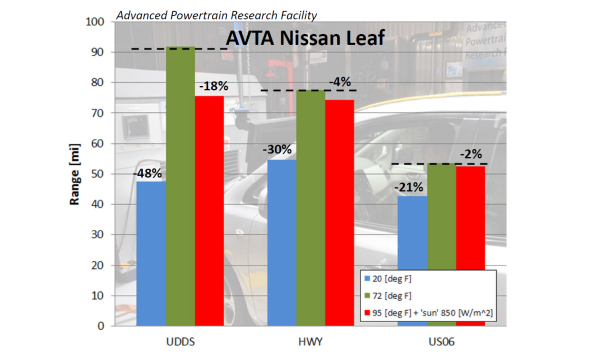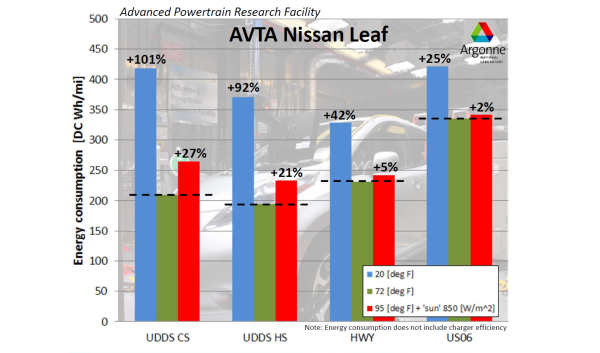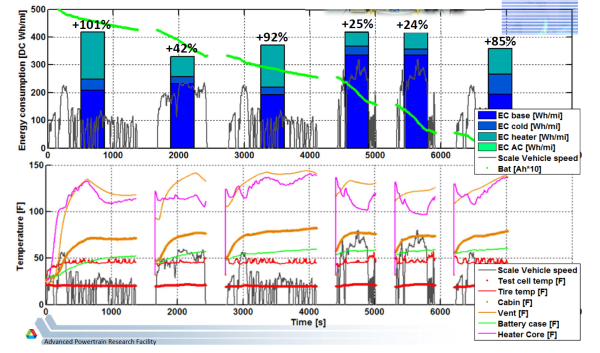The Tesla Model S Controversy: Understanding the Effects of Temperature on Electric Vehicle Efficiency and Range
by Vivek Gowri on February 18, 2013 4:22 PM EST- Posted in
- Auto
- Electric Vehicles
- Tesla Model S
- Nissan Leaf
Thermal Effects on Energy Consumption and Range
Looking at energy consumption, right off the bat, we can see that cold weather has a significant impact on EC - nearly double in urban driving, 40% more in the highway cycle, and 25% on the US06. It’s worth noting here: the Leaf has an 80 kW electric motor, a 24 kWh battery, and a 5 kW resistive heating element.
When broken down further, into a base load case (driving cycle EC at 72F), the amount of extra energy needed to drive the cycle at 20F (listed as EC cold), and then the heater load required to maintain a cabin temperature of 72F, we can see that a significant portion of the additional energy consumption is down to the heater. As with most gasoline cars, driving in sub-freezing temperatures only makes the car about 10% less efficient before heater loads are considered. The mechanically-driven heating elements in conventional vehicles add another 5% or so in terms of mechanical efficiency loss, while obviously the electric heater in the EV is far more costly from an energy consumption standpoint even though it doesn’t increase mechanical losses at all.
(Note: graphs were created by ANL using the raw 10Hz data instead of the filtered 1Hz data available on D3. Available as part of APRF's AVTA Nissan Leaf testing analysis and summary, as presented by Dr. Henning Lohse-Busch. Full presentation available here.)
And while energy consumption is a big deal, range is the be-all, end-all concern for most consumers. With the heater on, that’s a decrease in range by anywhere from 20-50% depending on your drive cycle. That’s a lot. And you can just look at the APRF’s full charge tests at 20F and 72F to see what I mean:
 Think about that - this is a car that, at launch, Nissan claimed had a 100 mile range. My own real-world driving suggests 80-85 a decent estimate. EPA says that number is closer to 73. The APRF’s instrumented testing backs that up (74.1 mile range at 72F), but the same instrumented testing, in 20F weather? 46 miles. That’s it.
Think about that - this is a car that, at launch, Nissan claimed had a 100 mile range. My own real-world driving suggests 80-85 a decent estimate. EPA says that number is closer to 73. The APRF’s instrumented testing backs that up (74.1 mile range at 72F), but the same instrumented testing, in 20F weather? 46 miles. That’s it.













102 Comments
View All Comments
law99 - Tuesday, February 19, 2013 - link
I find the argument that you just need to "change your driving style" without merit to probably half the UK population (complete guess), if not more considering the cost of the vehicle.The fact remains that charging is inconvenient even to those that can. I live in shared accommodation in a house consisting of two flats. There is space for 2 cars on our drive. 2 people in the house must commute 80miles a day to work. The others 4 need commute anywhere between 15 - 40.
So if we were driving electric cars, what the hell would we do? It doesn't matter whether I have a lead foot in my 1.4 tdi... I don't have to fight for drive space to charge my car over night. Especially considering I don't know downstairs very well. There aren't charging stations on the street either... and I'm not running a cable out there. There is a house just down the road for dysfunctional and unfortunately parent-less teens who would play havoc with that idea late at night. (And I live in a *good* area)
I don't want to extrapolate from this really, but a very real possibility is that there are more people in the world living like this. That can't just, change their driving style. And see the Top Gear review and the fact it was thrown out of court for actually being factually accurate and realise that electric cars, just aren't there yet. They can't cope with our wallets, our commutes and our living spaces.
The best solution I've seen so far is that a fuelling station would physically replace your battery. So you'd drive in and it would be pulled out from under you and a new one would be inserted. Otherwise we are waiting on hydrogen, better hybrids or continue using diesel for long range.
law99 - Tuesday, February 19, 2013 - link
I 'd like to add to this that even if the charge times come down to 3 hours... what are we to do? I get home at 6 along with my flatmate. My friends partner at 5, and my partner at 6.2 hours charge takes us to 9. Another to 12. I'm out of the house by 7:30 am. The perpetual juggling of charge times is going to be untenable and impractical with a potential to put a strain on relationships (I couldn't get to work because you were on the drive??? No thanks).
The only hope would be that work install a charging station for all vehicles. Do you expect companies to make this outlay? I don't.
My car can return 60+ mpg and cost less than £2000 to buy.
chipkin - Tuesday, February 19, 2013 - link
The Leaf can be fully charged at a Level 3 station in 25 minutes, and there are quite a few in the Chicago area. For 2013, the charging time from a Level 2 station was cut roughly in half, to 4 hours from TOTALLY dead. How often would it be totally dead? Never, really... An 80% Level 2 charge takes around 3 hours.You should also remember that in many urban areas there are free L2 stations all over the place, so you will be picking up charge piecemeal, and are unlikely to come home with the "Low Range" light flashing.
muy - Tuesday, February 19, 2013 - link
comparing an electric vehicle to something like a vw golf diesel that can do Berlin to Moskow on a single fuel tank is stupid.electric vehicles have way different limitations and at this moment simply can't be compared.
if you do more than 100 km a day, liquid fossil fuel driven vehicles rule supreme.
if you do less than 100 km a day, electric is a valid alternative.
apples and pears.
Shadowmaster625 - Tuesday, February 19, 2013 - link
So if you charge the battery to 28%, you get a range of 50 miles. Which is how far it drove when the idiot reporter charged it to 28%.foxalopex - Tuesday, February 19, 2013 - link
I recently bought myself a Chevy Volt. While I admit it is a bit expensive, I like technology so this was a car that was somewhat affordable and fit my lifestyle.To be honest, there's no significant changes in my driving style. Since I already live in a very cold part of Canada (Northern Ontario), I was already use to plugging the car in. Normally with a gas car you need to plug in a block heater anyhow in the winter. Thou I have to admit despite the relatively slow 0-60 (faster than a prius but no sports car) it has a lot of punch due to an electric having torque right off the line. I have noticed it makes it fairly easy to speed past normal cars as you can have the petal floored and no one can tell the difference since they can't hear you either. It also doesn't impact the battery as much as I thought it would. Probably the only major change is the slightly longer stopping distance compared to my former corolla due to weight. It corners and accelerates better probably due to traction control.
As far as weather, the car's mostly unaffected because the gas engine will kick in when it gets too cold for the battery to maintain itself. The only time I've seen weather really affect the volt is when it bottoms out to less than -4F and you didn't bother to plug the car in for 8+ hours. Then the battery shuts down due to extreme cold and the car becomes gas only which unfortunately makes it somewhat sluggish. But to it's merit, a gas car left in those conditions is about the same, a diesel probably even worse. Thou I'll admit one hilarious change is that when it is warmer, I am tempted to drive it for fun as a pure electirc.
I don't think pure EV's will reach mainstream unless battery technology significantly improves which will probably take a decade or two at least. The only viable technology I've heard of are induction based charging systems where your car charges as you drive. Until then I think a plug in hybrid like electric with a huge battery like the Volt is your best compromise.
I think this is why the Volt won so many awards and is highly rated by their owners including myself.
humbi83 - Tuesday, February 19, 2013 - link
As I see it there are 2 main things to the ICE vs EV debate.1. how much energy you can store in a cubic cm
2. how fast you replenish that energy.
1. It's complicated, nature is very good at getting stuff optimized. But please be aware that it had billions of years to do it. In the end we'll be able to copy that and say that it was a great discovery. I would say that petrol can be considered as a very convenient battery. Even nuclear is still our way of bowing down to the laws of nature. But for the moment we are working on it.
SO, if 1 is not our main forte point, than at least we should try to replicate the delivery method. This brings us to the 2nd point:
2. At least we should try to have a way of topping up that is on par with the current petrol delivery method. So MAKE IT LIQUID. You go to a "battery" pump and simply replace the old juice with the new one. Collect it and recharge. Do this in a centralized way and we are set. Now this is not concept but already in development. I see it coming in the near future.
I think this makeshift way of charging at home is not the future, you cannot & should not plan per individual. We need to have some special, centralized way of handling this. Some big charging station that gets old juice and delivers a newly charged one. In this way you can scale & make use of delivered pow 100% of the time and not produce it "just in case" 10k ppl try to charge at the same time. You basically average the consumption and normalize the peeks to a manageable constant. In this way you can also plan your power infrastructure accordingly.
humbi83 - Tuesday, February 19, 2013 - link
Oh .. let's not forget fuel cells. NASA has been using fuel cells for the past half a century. They have 60~70% eff + electric motor 90-99% eff resulting in a combined 54->70% eff. Much better then current power trains.Doug_G - Tuesday, February 19, 2013 - link
I have driven my Model S on several road trips in very cold temperatures - down to 0F - and have done 190 mile legs with a 20 mile safety buffer still remaining. In extreme cold I do recommend keeping your speeds moderate (say 55 mph) and using the "Range Mode" for the heating system (still plenty warm enough).Other handy tips for cold trips: you want to do a "Range Mode" charge just before leaving, so the batteries are nice and toasty. Since you can continuously monitor the projected range, I try to drive to maintain a 20 mile "safety buffer" compared to the GPS display. If you're doing better than that, you can speed up; if worse, you should slow down a little.
Of course 99% of your driving is "around town", and for that the Model S has plenty of range to spare - you don't even bother looking at the range display. You plug in when you get home, just like a cell phone, so every morning you have a "full tank" and can blast around town with no concern for range whatsoever. You don't need any charging infrastructure except a 240V plug in your own garage.
BoloMKXXVIII - Tuesday, February 19, 2013 - link
All this talk about heating, but I live in the south where A/C is more important than heat. How much does the A/C impact range? Also, when you have 200 - 300 mile range, who is really going to have range anxiety? Most families have two cars. One pure electric seems doable for most families. I for one would love one once the prices get a bit more realistic. I will keep my full sized truck for hauling and long trips. The EV will get 90%+ of all the mileage.